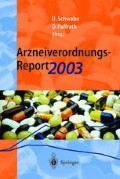Zusammenfassung
In der Gruppe der Mineralstoffpräparate werden verschiedene Mineralsalze nach chemischer Systematik zusammengefaßt, die therapeutisch mehreren Indikationen zuzuordnen sind. Hauptvertreter sind die Calcium-, Kalium- und Magnesiumpräparate, die primär für die Substitution bei entsprechenden Mangelzuständen in Frage kommen. Daneben gibt es kleinere Präparategruppen, die Fluorid, Zink, Aluminium, Selen oder Kupfer enthalten.
Access this chapter
Tax calculation will be finalised at checkout
Purchases are for personal use only
Preview
Unable to display preview. Download preview PDF.
Literatur
American Medical Association (1986): Agents affecting calcium metabolism. In: Drug Evaluations, 6th ed., Saunders Company, Philadelphia, pp. 827–839, 885-902.
Arzneimittelkommission der Deutschen Ärzteschaft (2003): Empfehlungen zur Therapie und Prophylaxe der Osteoporose. Arzneiverordnung in der Praxis (Sonderheft 34S).
Bone H.G., Greenspan S.L., McKeever C. et al. (2000): Alendronate and estrogen effects in postmenopausal women with low bone mineral density. J. Clin. Endocrinol. Metab. 85: 720–726.
Dawson-Hughes B., Harris S.S., Krall E.A., Dallai G.E. (1997): Effect of calcium and vitamin D supplementation on bone density in men and women 65 years of age or older. N. Engl. J. Med. 337: 670–676.
Fleisch H. (1997): Bisphosphonates in bone disease. From the laboratory to the patient. Parthenon Publ. Group, New York London pp. 1–184.
Galloe A.M., Rasmussen H.S., Jorgensen L.N., Aurup P., Balslov S. et al. (1993): Influence of oral magnesium supplementation on cardiac events among survivors of an acute myocardial infarction. Brit. Med. J. 307: 585–587.
ISIS-4 Collaborative Group (1995): ISIS-4: a randomised Arctoriol trial assessing early oral Captopril, oral mononitrate and intravenous magnesium sulphate in 58050 patients with suspected acute myocardial infarction. Lancet 345: 669–685.
Kuhlmann U., Siegenthaler W., Siegenthaler G. (1987): Wasser-und Elektrolythaushalt. In: Siegenthaler W. (Hrsg.): Klinische Pathophysiologie. Georg Thieme Verlag, Stuttgart New York, S. 209–237.
Manz M., Mletzko R., Jung W., Lüderitz B. (1990): Behandlung von Herzrhythmusstörungen mit Magnesium. Dtsch. Med. Wschr. 115: 386–390.
Miller P.D., Watts N. B., Licata A.A. et al. (1997): Cyclical etidronate in treatment of postmenopausal osteoporosis. Am. J. Med. 103: 468–476.
Neer R.M., Arnaud CD., Zanchetta J.R., Prince R., Gaich G.A., Reginster J.Y. et al. (2001): Effect of parathyroid hormone (1-34) on fractures and bone mineral density in postmenopausal women with osteoporosis. N. Engl. J. Med. 344: 1434–1441.
NIH Consensus Conference (1994): Optimal calcium intake. JAMA 272: 1942–1948.
Riggs B.L., O’Fallón W.M., Lane A., Hodgson S.F., Wahner H.W. et al. (1994): Clinical trial of fluoride therapy in postmenopausal osteoporotic women: Extended observations and additional analysis. J. Bone Miner. Res. 9: 265–275.
Wüster C, Ziegler R. (1993): Fluorid-Therapie der Osteoporose: „Auf die Dosis kommt es an“. Dtsch. Ärztebl. 90: B-41–42.
Zehender M., Meinertz T., Faber T., Caspary A., Jeron A. et al. (1997): Antiarrhythmic effects of increasing the daily intake of magnesium and potassium in patients with frequent ventricular arrhythmias. J. Am. Coll. Cardiol. 29:1028–1034.
Ziegler R. (2002): Osteoporose: aktuelle Diagnostik und Therapie. Orthopädische Praxis 38: 570–577.
Editor information
Editors and Affiliations
Rights and permissions
Copyright information
© 2004 Springer-Verlag Berlin Heidelberg
About this chapter
Cite this chapter
Schwabe, U., Ziegler, R. (2004). Mineralstoffpräparate und Osteoporosemittel. In: Schwabe, U., Paffrath, D. (eds) Arzneiverordnungs-Report 2003. Springer, Berlin, Heidelberg. https://doi.org/10.1007/978-3-642-18512-0_36
Download citation
DOI: https://doi.org/10.1007/978-3-642-18512-0_36
Publisher Name: Springer, Berlin, Heidelberg
Print ISBN: 978-3-540-40188-9
Online ISBN: 978-3-642-18512-0
eBook Packages: Springer Book Archive

